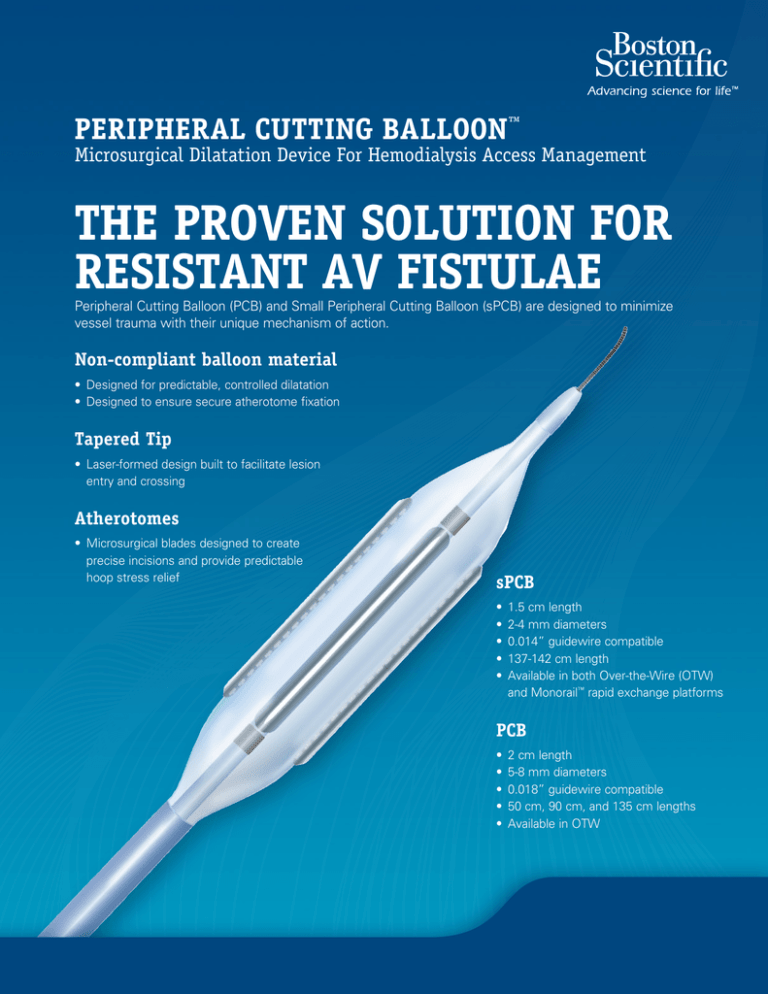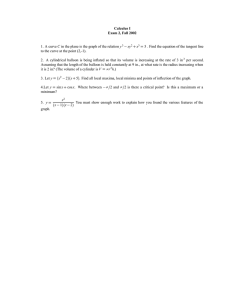
PERIPHERAL CUTTING BALLOON™
Microsurgical Dilatation Device For Hemodialysis Access Management
THE PROVEN SOLUTION FOR
RESISTANT AV FISTULAE
Peripheral Cutting Balloon (PCB) and Small Peripheral Cutting Balloon (sPCB) are designed to minimize
vessel trauma with their unique mechanism of action.
Non-compliant balloon material
• Designed for predictable, controlled dilatation
• Designed to ensure secure atherotome fixation
Tapered Tip
•Laser-formed design built to facilitate lesion
entry and crossing
Atherotomes
•Microsurgical blades designed to create
precise incisions and provide predictable
hoop stress relief
sPCB
• 1.5 cm length
• 2-4 mm diameters
• 0.014” guidewire compatible
• 137-142 cm length
•Available in both Over-the-Wire (OTW)
and Monorail™ rapid exchange platforms
PCB
• 2 cm length
• 5-8 mm diameters
• 0.018” guidewire compatible
• 50 cm, 90 cm, and 135 cm lengths
• Available in OTW
Product Information
Inflation Port
Guidewire Port
Over-the-Wire PCB 2 cm Balloon Catheter
UPN
Catalog
Diameter
Usable Length
M001PCB5020500
PCB502050
5 mm
50 cm
M001PCB6020500
PCB602050
6 mm
50 cm
M001PCB7020500
PCB702050
7 mm
50 cm
M001PCB8020500
PCB802050
8 mm
50 cm
M001PCB5020900
PCB502090
5 mm
90 cm
M001PCB6020900
PCB602090
6 mm
90 cm
M001PCB7020900
PCB702090
7 mm
90 cm
M001PCB8020900
PCB802090
8 mm
90 cm
M001PCB50201350
PCB5020135
5 mm
135 cm
M001PCB60201350
PCB6020135
6 mm
135 cm
M001PCB70201350
PCB7020135
7 mm
135 cm
M001PCB80201350
PCB8020135
8 mm
135 cm
24 cm Exchange Length
Inflation Port
Monorail™ sPCB 1.5 cm Balloon Catheter
UPN
Catalog
Diameter
Usable Length
M001PCBM2015140F0
PCBM2015140F
2 mm
137 cm
M001PCBM2515140F0
PCBM2515140F
2.5 mm
137 cm
M001PCBM3015140F0
PCBM3015140F
3 mm
137 cm
M001PCBM3515140F0
PCBM3515140F
3.5 mm
137 cm
M001PCBM4015140F0
PCBM4015140F
4 mm
137 cm
Inflation Port
Guidewire Port
Over-the-Wire sPCB 1.5 cm Balloon Catheter
UPN
Catalog
Diameter
Usable Length
M001PCBO2015140F0
PCBO2015140F
2 mm
142 cm
M001PCBO2515140F0
PCBO2515140F
2.5 mm
142 cm
M001PCBO3015140F0
PCBO3015140F
3 mm
142 cm
M001PCBO3515140F0
PCBO3515140F
3.5 mm
142 cm
M001PCBO4015140F0
PCBO4015140F
4 mm
142 cm
SMALL PERIPHERAL CUTTING BALLOON™ MICROSURGICAL DILATATION DEVICE OTW AND MONORAIL
2 CM PERIPHERAL CUTTING BALLOON™ MICROSURGICAL DILATATION DEVICE
CAUTION: Federal law (USA) restricts this device to sale by or on the order of a physician. Rx only. Prior to use, please see the complete “Directions for Use” for more
information on Indications, Contraindications, Warnings, Precautions, Adverse Events, and Operator’s Instructions.
INTENDED USE/INDICATIONS FOR USE: The Peripheral Cutting Balloon catheters are indicated for Percutaneous Transluminal Angioplasty (PTA) of obstructive lesions of
synthetic or native arteriovenous dialysis fistulae. CONTRAINDICATIONS: • Use of the Cutting Balloon Device is contraindicated in situations where the Cutting Balloon
Device would be passed through the struts of a previously placed stent as the deflated Cutting Balloon Device could become entangled in the stent. • The Peripheral Cutting
Balloon Device is not for use in the coronary arteries or carotid arteries. • The Peripheral Cutting Balloon Device is not intended for the expansion or delivery of stents.
WARNINGS: • The Cutting Balloon Device should be used before new stent placement. Exercise extreme care when treating a lesion distal to a previously placed stent.
If the guidewire has passed through the stent cell rather than down the axis of the stent, the deflated Cutting Balloon Device could become entangled in the stent. Confirm
wire position in two views before advancing the Cutting Balloon Device if crossing a previously placed stent. Excessive withdrawal pressure against resistance can damage
the Device and potentially require surgery for retrieval. When treating lesions at a bifurcation, the Cutting Balloon Device can be used prior to placing a stent, but should
not be taken through the side cell of a stent to treat the side branch of a lesion at a bifurcation where a stent has been previously placed. • Angioplasty with the Peripheral
Cutting Balloon Device, because of its mechanism of action, may pose a greater risk of perforation than that observed with conventional PTA. Oversizing increases the risk
of perforation. To reduce the potential for vessel damage the inflated diameter of the Peripheral Cutting Balloon Device should not exceed a 1.1:1 ratio of the diameter of
the vessel just proximal and distal to the stenosis. • Balloon pressure should not exceed the rated burst pressure. The rated burst pressure is based on the results of in vitro
testing. At least 99.9% of the balloons, (with a 95% confidence) will not burst at or below their rated burst pressure. Use of a pressure monitoring device is recommended to
prevent over pressurization. • Use only the recommended balloon inflation medium (e.g. - contrast medium). Never use air or any gaseous medium to inflate the balloon.
• Do not use in a kinked or buckled introducer sheath or if resistance is encountered. Resistance, kinking, or buckling in the introducer sheath may damage the atherotomes or
balloon. If any of these occur, immediately withdraw both devices. • When the catheter is exposed to the vascular system, it should be manipulated while under high-quality
fluoroscopic observation. Do not advance or retract the catheter unless the balloon is fully deflated under vacuum. If resistance is met during manipulation, determine the
cause of the resistance before proceeding. PRECAUTIONS: Prior to angioplasty, the catheter should be examined to verify functionality and ensure that its size and shape
are suitable for the specific procedure for which it is to be used. Only physicians who have received the appropriate training should use the Peripheral Cutting Balloon Device.
During the Peripheral Cutting Balloon Device procedure, appropriate anticoagulant therapy should be provided to the patient. Anticoagulant therapy should be continued after
the procedure for a period of time to be determined by the physician. The Peripheral Cutting Balloon Device is not designed for, and therefore, cannot be used to monitor in
vivo arterial pressures. POTENTIAL ADVERSE EVENTS: Risks associated with interventional treatment of stenosis with the Peripheral Cutting Balloon Device are similar
to those of conventional PTA. Potential risks include, but are not limited to: • Allergic or drug reaction (device material, contrast medium and medications) • Amputation
• Arteriovenous fistula • Death • Embolism • Hematoma • Hemorrhage • Hypotension/hypertension • Infection/Sepsis • Ischemia/infarction of tissue/organ • Pain
• Pseudoaneurysm • Restenosis • Surgical intervention • Swelling • Thrombosis • Vessel injury (dissection, perforation, or rupture) • Vessel occlusion • Vessel spasm
REV AA
Peripheral Cutting Balloon and Monorail are registered or unregistered trademarks of Boston Scientific Corporation or its affiliates.
Peripheral Interventions
300 Boston Scientific Way
Marlborough, MA 01752-1234
www.bostonscientific.com
To order product or for more information
contact customer service at 1.888.272.1001.
© 2015 Boston Scientific Corporation
or its affiliates. All rights reserved.
PI-284207-AA MAR2015





